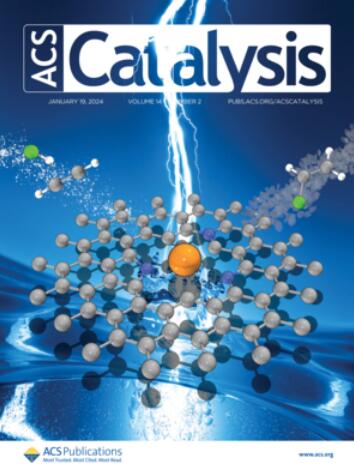Universal Descriptors of Propane Dehydrogenation Activity at Atomically Dispersed Metal–X Sites (X = O, S, C, and N): Machine Learning-Powered Inverse Catalyst Design
IF 13.1
1区 化学
Q1 CHEMISTRY, PHYSICAL
引用次数: 0
Abstract
Atomically dispersed metal–X (M–X) sites (X = O, S, C, and N) have shown great promise as active centers for propane dehydrogenation (PDH). In this work, the formation energies of adsorbed H at the X site (EH@X) and coadsorbed H&H at the M–X site (EH&H@M–X) are identified as two universal descriptors of the PDH activity at M–X sites by establishing their scaling relations with the rate-determining state energies. The derived volcano-shaped activity map is capable of providing a rational interpretation of experimentally reported catalysts. To rapidly predict EH@X and EH&H@M–X without DFT calculations, motif-specific features, including intrinsic elemental properties and the number of atoms characterizing the coordination environments, are constructed to train two extra-trees regression models to perform a multitiered virtual screening of 1,659,373 potential catalysts. Pt1Co1–Ga2O3 is found to show a higher activity than previously known Ir1–Ga2O3, because the substrate imposes a specific geometrical arrangement of the surface Pt, Co, Ga, and O atoms, which strengthens the binding of the rate-determining transition state through Lewis acid–base interactions and therefore imparts specific function to the highly active Pt–O site for PDH. These findings provide a general strategy for the inverse catalyst design by combining DFT-based microkinetic analysis with machine-learning algorithms.

丙烷在原子分散的金属- X位(X = O, S, C和N)上脱氢活性的通用描述符:机器学习驱动的反催化剂设计
原子分散的金属- X (M-X)位(X = O, S, C和N)作为丙烷脱氢(PDH)的活性中心显示出很大的希望。在这项工作中,通过建立它们与速率决定态能量的标度关系,确定了X位点上吸附H的形成能(EH@X)和M-X位点上共吸附H的形成能(EH&H@M -X)是M-X位点上PDH活性的两个通用描述符。导出的火山状活动图能够为实验报道的催化剂提供合理的解释。为了在没有DFT计算的情况下快速预测EH@X和EH&;H@M -X,构建了特定于基序的特征,包括内在元素性质和表征配位环境的原子数量,以训练两个额外的树回归模型,对1,659,373个潜在催化剂进行多层虚拟筛选。Pt1Co1-Ga2O3比Ir1-Ga2O3表现出更高的活性,因为底物施加了表面Pt, Co, Ga和O原子的特定几何排列,通过刘易斯酸碱相互作用加强了速率决定过渡态的结合,因此赋予了PDH高活性Pt - O位点特定的功能。这些发现通过将基于dft的微动力学分析与机器学习算法相结合,为逆催化剂设计提供了一种通用策略。
本文章由计算机程序翻译,如有差异,请以英文原文为准。
求助全文
约1分钟内获得全文
求助全文
来源期刊

ACS Catalysis
CHEMISTRY, PHYSICAL-
CiteScore
20.80
自引率
6.20%
发文量
1253
审稿时长
1.5 months
期刊介绍:
ACS Catalysis is an esteemed journal that publishes original research in the fields of heterogeneous catalysis, molecular catalysis, and biocatalysis. It offers broad coverage across diverse areas such as life sciences, organometallics and synthesis, photochemistry and electrochemistry, drug discovery and synthesis, materials science, environmental protection, polymer discovery and synthesis, and energy and fuels.
The scope of the journal is to showcase innovative work in various aspects of catalysis. This includes new reactions and novel synthetic approaches utilizing known catalysts, the discovery or modification of new catalysts, elucidation of catalytic mechanisms through cutting-edge investigations, practical enhancements of existing processes, as well as conceptual advances in the field. Contributions to ACS Catalysis can encompass both experimental and theoretical research focused on catalytic molecules, macromolecules, and materials that exhibit catalytic turnover.
 求助内容:
求助内容: 应助结果提醒方式:
应助结果提醒方式:


